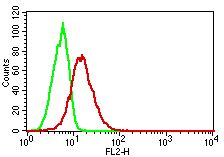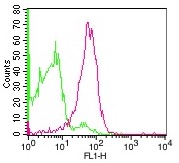Mouse Ephrin-A1 / EFNA1 Recombinant Protein (Fc Tag)(Discontinued)
Shipping Info:
For estimated delivery dates, please contact us at [email protected]
| Amount : | 200 µg |
| Purification : | > 85 % as determined by SDS-PAGE |
| Content : | Formulation Lyophilized from sterile PBS, pH 7.4 Normally 5 % - 8 % trehalose, mannitol and 0.01% Tween80 are added as protectants before lyophilization. |
| Storage condition : | Store it under sterile conditions at -20°C to -80°C. It is recommended that the protein be aliquoted for optimal storage. Avoid repeated freeze-thaw cycles. |
| AA sequence : | Met1-Ser182 |
| Alternative Name : | AI325262 Protein, Mouse; B61 Protein, Mouse; Efl1 Protein, Mouse; Epl1 Protein, Mouse; Eplg1 Protein, Mouse; Lerk1 Protein, Mouse |
Source : HEK293 Cells
EPH-related receptor tyrosine kinase ligand 1 (abbreviated as Ephrin-A1) also known as ligand of eph-related kinase 1 or EFNA1, is a member of the ephrin (EPH) family. The Eph family receptor interacting proteins (ephrins) are a family of proteins that serve as the ligands of the Eph receptor, which compose the largest known subfamily of receptor protein-tyrosine kinases (RTKs). Ephrin-A1/EFNA1 and its Eph family of receptor tyrosine kinases are expressed by cells of the SVZ. Ephrin subclasses are further distinguished by their mode of attachment to the plasma membrane: ephrin-A ligands bind EphA receptors and are anchored to the plasma membrane via a glycosylphosphatidylinositol (GPI) linkage, whereas ephrin-B ligands bind EphB receptors and are anchored via a transmembrane domain. An exception is the EphA4 receptor, which binds both subclasses of ephrins. Ephrin-A1 and one of its receptor EphA2 were expressed in xenograft endothelial cells and also tumor cells and play a role in human cancers, at least in part by influencing tumor neovascularization.
EPH-related receptor tyrosine kinase ligand 1 (abbreviated as Ephrin-A1) also known as ligand of eph-related kinase 1 or EFNA1, is a member of the ephrin (EPH) family. The Eph family receptor interacting proteins (ephrins) are a family of proteins that serve as the ligands of the Eph receptor, which compose the largest known subfamily of receptor protein-tyrosine kinases (RTKs). Ephrin-A1/EFNA1 and its Eph family of receptor tyrosine kinases are expressed by cells of the SVZ. Ephrin subclasses are further distinguished by their mode of attachment to the plasma membrane: ephrin-A ligands bind EphA receptors and are anchored to the plasma membrane via a glycosylphosphatidylinositol (GPI) linkage, whereas ephrin-B ligands bind EphB receptors and are anchored via a transmembrane domain. An exception is the EphA4 receptor, which binds both subclasses of ephrins. Ephrin-A1 and one of its receptor EphA2 were expressed in xenograft endothelial cells and also tumor cells and play a role in human cancers, at least in part by influencing tumor neovascularization.
Measured by its binding ability in a functional ELISA. Immobilized Mouse EphA2 at 2 µg/ml (100 µL/well) can bind mouse EphrinA1 with a linear range of 0.16-20 ng/ml .
Endotoxin :< 1.0 EU per µg of the protein as determined by the LAL method
For Research Use Only. Not for use in diagnostic/therapeutics procedures.
|
There are currently no product reviews
|





















.png)









